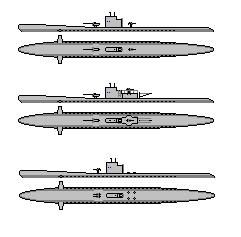I-15/Tamasika Class Coastal Submarine

Top to Bottom:
I-15 class coastal submarine
I-21 class atypical operations submarine
I-22 class minelaying coastal submarine
A planned run of six boats. Officially reported as 450 t boats, the class is somewhat larger than the preceeding I-2 and I-9 classes on account of a greater operating radius, larger powerplant, and heavier armament.
Though technically coastal boats, there is an expectation that the class should be able to operate in the eastern Indian Ocean and the western Pacific, allowing the larger I-6 and I-11 classes to focus on the more distal western Indian Ocean.
Tamasika (Vengeful), I-15, laid down 1929
Upadravi (Rowdy), I-16, laid down 1929
Imanadara (Upright), I-17, laid down 1929
Jiddi (Stubborn), I-18, laid down 1929
Asanta (Turbulent), I-19, laid down 1930
Calaka (Clever), I-20, laid down 1930
Length, 59.0 m x Beam, 6.2 m x Depth, 4.0 m
590 tonnes normal displacement (466 tonnes standard)
Main battery: 1 x 10.5-cm
Secondary battery: 1 x 3.5-cm
Weight of broadside: 17 kg
6 TT, 55.0 cm (submerged) (4F, 2A), 12 torpedoes
Hull unarmored
Battery armor:
Main, 2.0 cm shields / secondary, 2.0 cm shields
Maximum speed for 1798 shaft kw = 18.29 knots
Approximate cruising radius, 8000 nm / 12 knots
Operational Diving Depth: 53 m
Emergency Depth: 85 m
Crush Depth: 132 m
Typical complement: 60-78
Misc. Weight:
-12 t for six torpedo reloads
-108 t for ballast tanks (18.3% of normal weight)
Estimated cost, $480,000 (£120,000)
Remarks:
Caution: lacks seaworthiness -- very limited seakeeping ability.
Caution: Magazines and engineering spaces are very cramped,
and lack adequate watertight subdivision.
Caution: Very cramped ship with excessively poor habitability;
lacks suitable working space.
Ship has quick, 'lively' roll; not a steady gun platform.
Distribution of weights:
Percent
normal
displacement:
Armament ......................... 5 tonnes = 1 pct
Armor, total ..................... 1 tonnes = 0 pct
Armament 1 tonnes = 0 pct
Machinery ........................ 74 tonnes = 13 pct
Hull and fittings; equipment ..... 252 tonnes = 43 pct
Fuel, ammunition, stores ......... 139 tonnes = 24 pct
Miscellaneous weights ............ 120 tonnes = 20 pct
-----
590 tonnes = 100 pct
Estimated metacentric height, 0.1 m
Displacement summary:
Light ship: 451 tonnes
Standard displacement: 466 tonnes
Normal service: 590 tonnes
Full load: 687 tonnes
Loading submergence 200 tonnes/metre
+++++++++++++++++++++++++
Estimated overall survivability and seakeeping ability:
Relative margin of stability: 1.00
Shellfire needed to sink: 23 kg = 1.4 x 10.5-cm shells
(Approximates weight of penetrating
shell hits needed to sink ship,
not counting critical hits)
Torpedoes needed to sink: 0.0
(Approximates number of 'typical'
torpedo hits needed to sink ship)
Relative steadiness as gun platform, 1 percent
(50 percent is 'average')
Relative rocking effect from firing to beam, 0.00
Relative quality as a seaboat: 0.00
+++++++++++++++++++++++++
Hull form characteristics:
Block coefficient: 0.40
Sharpness coefficient: 0.30
Hull speed coefficient 'M' = 7.05
'Natural speed' for length = 13.9 knots
Power going to wave formation
at top speed: 50 percent
Estimated hull characteristics and strength:
Relative underwater volume absorbed by
magazines and engineering spaces: 244 percent
Relative accommodation and working space: 1 percent
Displacement factor: 193 percent
(Displacement relative to loading factors)
Relative cross-sectional hull strength: 2.32
(Structure weight per square
metre of hull surface: 343 kg)
Relative longitudinal hull strength: 1.64
(for 0.03 m average freeboard;
freeboard adjustment -2.59 m)
Relative composite hull strength: 1.78
+++++++++++++++++++++++++
[Machine-readable parameters: Spring Style v. 1.2.1]
193.52 x 20.34 x 13.12; 0.10 -- Dimensions
0.40 -- Block coefficient
1929 -- Year laid down
18.29 / 8000 / 12.00; Oil-fired turbine or equivalent -- Speed / radius / cruise
120 tons -- Miscellaneous weights
++++++++++
1 x 4.13; 0 -- Main battery; turrets
Central positioning of guns
Gun-shields
:
1 x 1.38; 0 -- Secondary battery; turrets
Gun-shields
:
0 -- No tertiary (QF/AA) battery
0 -- No fourth (light) battery
6 / 6 / 21.65 -- TT / submerged / size
++++++++++
0.00 -- No belt armor
0.00 / 0.00 -- Deck / CT
0.79 / 0.79 / 0.00 / 0.00 -- Battery armor
(Note: For portability, values are stored in Anglo-American units)
+++++++++++++++++++++++++++++++++++++++++++++++++++++++

